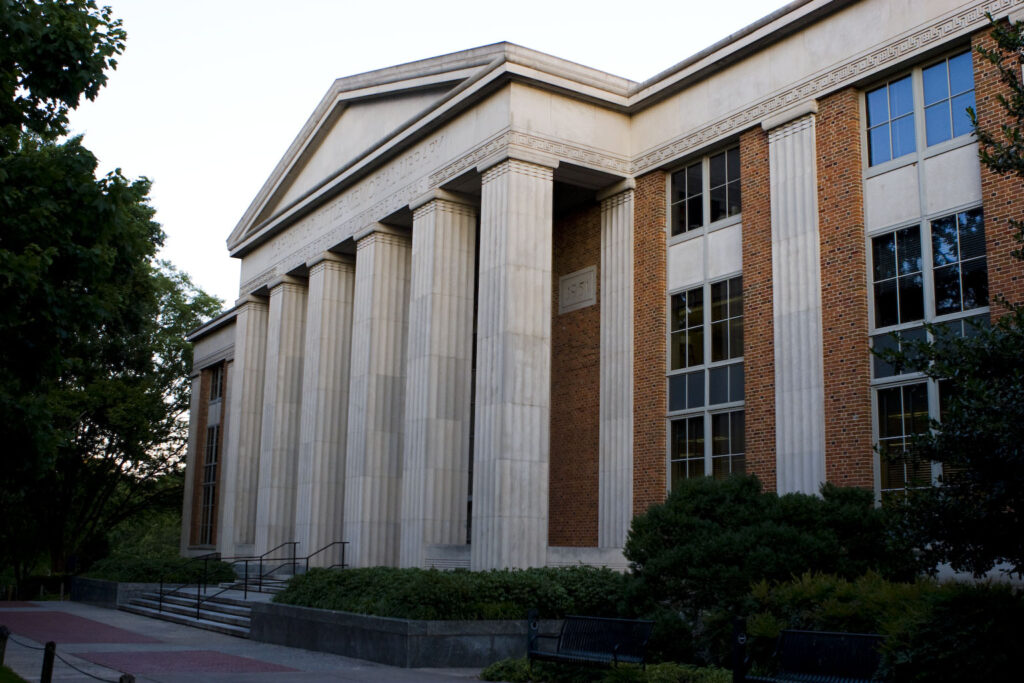Founded in Athens in 1938, the University of Georgia Press is the oldest and largest book publisher in the state and the only member of the Association of University Presses within the University System of Georgia. The press publishes sixty to seventy new books each year. Its mission is to produce distinguished, peer-reviewed publications that advance the intellectual, cultural, and environmental heritage of Georgia, the Southeast, and the nation.

Photograph from Zlatko Unger
Early Years
The press evolved from the public relations and publications department of the University of Georgia (UGA)—its first publications were financed through the sales of syllabi printed for survey courses. Nan Bryan, director of UGA’s printing department, served as the press’s first director. The first UGA Press faculty advisory committee was appointed by Bryan’s successor, Frazier Moore, in September 1938. The committee was responsible for advising the press in its selection of publication material and in the formulation of policies. In October 1939 Moore and UGA president Harmon Caldwell incorporated the operation, and in 1945 the university made a revolving fund of $10,000 available to the press. The university continues to subsidize the press today.
The press originally published books by UGA faculty members and brought rare southern titles back into print. In 1938, its first year of operation, the press produced only one book, Segments of Southern Thought, a collection of essays on southern life and letters by assistant professor of English Edd Winfield Parks. Over the years the publication program grew to include works written not only by Georgia natives and UGA professors but also by authors from other parts of the country and around the world.
By 1940 the press had published eight books, including Georgia: A Guide to Its Towns and Countryside (1940), Athenian Fred Birchmore’s Around the World on a Bicycle (1939), and Rae S. Neely’s Marguerite, the Sister and Wife of Kings (1939), the press’s first poetry book. Each of these titles enjoyed local and national media attention. Other early press publications include books on Georgia history and literature, southern history and literature, travel, nature writing, nature guides, short fiction, and poetry—subjects that continue to be represented in press catalogs.
Growth and Relocation
The press’s early success continued at a steady pace, and by 1943 administrators were already struggling with a lack of suitable storage space for books. The press offices were located in the Chancellor House, which stood where the Ilah Dunlap Little Memorial Library, known as the Main Library, stands today on UGA’s historic north campus. Books were stored in three inconveniently separate locations until 1989, when the press, with a growing backlist of nearly 600 books, consolidated its inventory and its shipping and receiving operations into a new warehouse space on Whitehall Road in east Athens. In 2005 the press’s order fulfillment and warehousing operations moved to a fully modernized distribution center on the Atlanta Highway in west Athens.

Image from TimothyJ
The UGA Press offices have moved five times since leaving the Chancellor House. The Press occupied three separate locations on north campus until settling in 1993 at Oakbrook Corporate Campus in east Athens. In 2010 the Press was reorganized as a unit of the University of Georgia Libraries, and in 2012 the offices moved into the Main Library on north campus.
Directors and Milestones
In the 1950s, 1960s, and 1970s, under the influential directorship of Moore’s successor, Ralph Stephens, a poet and former UGA English and journalism professor, the press began to build a reputation as a first-rate publisher of poetry and literary studies. Stephens inaugurated the prestigious Contemporary Poetry Series in 1970; the first volume in the series was The Snake Hunter by Harry Morris. The series remained active for more than thirty years, and individual titles garnered top awards, such as the National Book Critics Circle Award, which was given to poet Albert Goldbarth for his collection Heaven and Earth: A Cosmology in 1991. Stephens continued to foster the regional studies list, publishing one of the press’s all-time best sellers in 1975, Wildflowers of the Southeastern United States. By this time the press had 260 titles in print.
Paul Zimmer, also a poet, became director when Stephens retired in 1978. Zimmer expanded the scope of the publication program, and by 1981 the press was publishing forty new titles a year, up from about twenty in the 1970s. The increase in title output was partly due to Zimmer’s initiation of three new series in the 1980s—the Flannery O’Connor Award for Short Fiction (founded together with Charles East and named in honor of Georgia writer Flannery O’Connor), the Association of Writers and Writing Programs Award for Creative Nonfiction, and the Brown Thrasher Books imprint (reprints of Georgia classics). Two of the series, the Flannery O’ Connor Award and the Association of Writers and Writing Programs Award for Creative Nonfiction, are still active and held in high esteem today.
UGA Press editor Malcolm Call began his tenure as director in 1984, when Zimmer left to direct the University of Iowa Press. With Call at the helm, the press began publishing more trade titles (books intended for a larger, general audience), including a small list of full-length fiction by contemporary Georgia authors. He revitalized the list in southern and American history, particularly in the areas of African American studies and civil rights history. In the mid-1980s several press history books won prestigious awards, and three were chosen for the History Book Club. By 1988 the press’s total list numbered seventy to eighty titles per year. A third of these were trade books, and Call hired a national sales team, tripled advertising in general-interest publications, and hired a full-time publicist to support the new emphasis. The press won the Grand Prize for overall literary excellence in the Boston Globe Literary Press Competition in 1988.
After Call stepped down from the directorship and assumed the position of acquiring editor in 1994, the press’s executive editor, Karen Orchard, became interim director. Subsequently named director in 1995, Orchard developed an interdisciplinary list in environmental studies, with a particular focus on literary nature writing. She also supported a growing poetry list, which included a new series, The Life of Poetry: Poets on Their Art and Craft, and an agreement to publish every third winner of the Cave Canem Poetry Prize, awarded annually to an African American poet. Two original novels published by the press during this time won the Townsend Prize for Fiction: The Sweet Everlasting (1996) by Judson Mitcham and Daughter of My People (1998) by James Kilgo. (After the press published his second novel, Sabbath Creek [2004], Mitcham became the first author to win the award twice.) Orchard initiated the press’s first foray into electronic publishing in 1999 as a founding partner of the New Georgia Encyclopedia.
Twenty-first Century
When Orchard retired in 2001, the press had a backlist of 900 titles. Nicole Mitchell, former director of the University of Alabama Press in Tuscaloosa, became director in October 2001. Along with editor-in-chief Nancy Grayson, Mitchell focused on reviving and expanding the press’s regional publishing program and strengthening traditional scholarly areas of the list, including American and southern history and literature, African American studies, and American studies. The press continued its commitment to creative works and environmental studies as well.
The press also forged new alliances within the UGA community, developing series with editors from the university’s School of Public and International Affairs and Department of Geography. Other publishing partners included the Atlanta History Center; Georgia Humanities; the Southern Foodways Alliance, based in Oxford, Mississippi, and headed by Jones County native John T. Edge; and the Telfair Museum of Art (later Telfair Museums) in Savannah.
In 2004 Mitchell initiated the press’s first development effort by recruiting a director of development and building an advisory council of twenty members, including former governor Roy Barnes. In 2008 the press received a Governor’s Award in the Humanities and marked its seventieth anniversary by launching a five-year general endowment campaign.
In 2012 Lisa Bayer, the former marketing director at the University of Illinois Press in Champaign, succeeded Mitchell as press director. The press’s imprint is overseen by a faculty editorial board, whose primary role is to uphold the integrity of the peer-review process.










